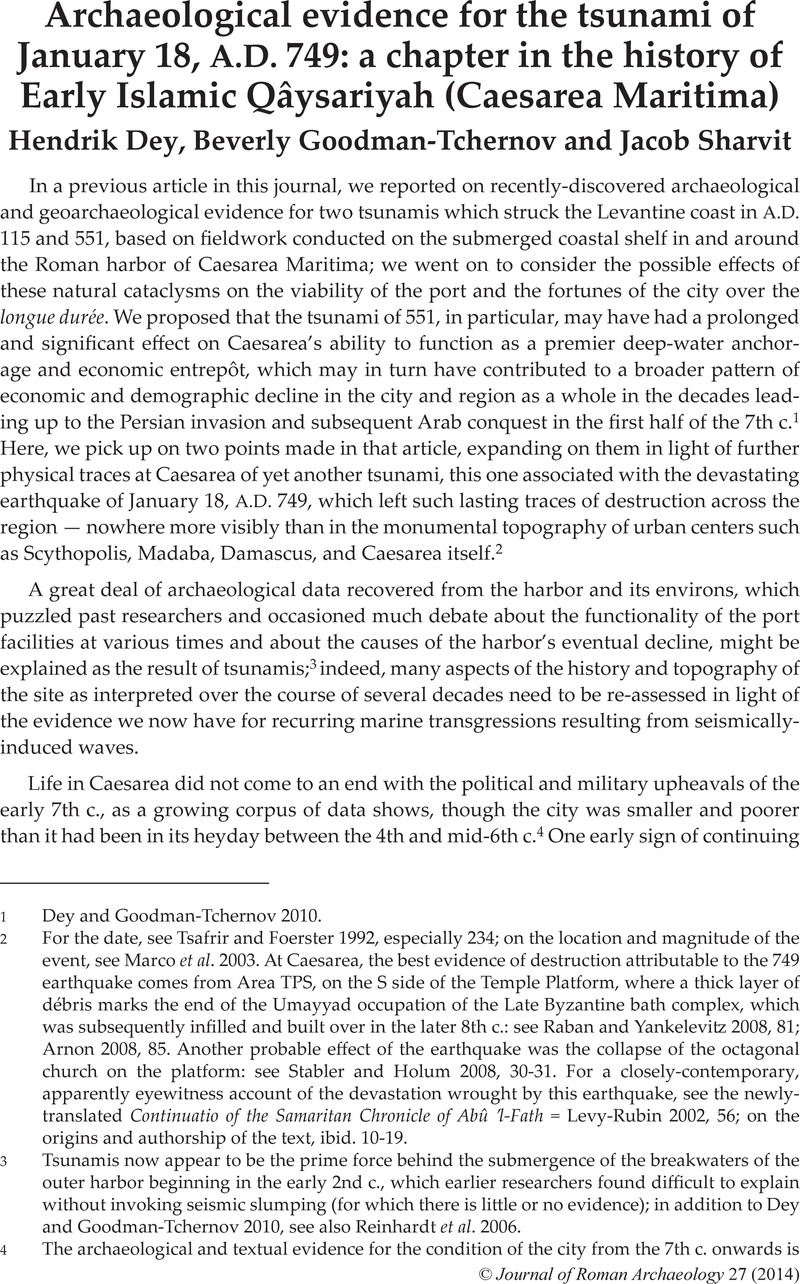Crossref Citations
This article has been cited by the following publications. This list is generated based on data provided by Crossref.
Goodman-Tchernov, Beverly N.
and
Austin, James A.
2015.
Deterioration of Israel's Caesarea Maritima's ancient harbor linked to repeated tsunami events identified in geophysical mapping of offshore stratigraphy.
Journal of Archaeological Science: Reports,
Vol. 3,
Issue. ,
p.
444.
Ramsay, Jennifer
and
Holum, Kenneth
2015.
An archaeobotanical analysis of the Islamic period occupation at Caesarea Maritima, Israel.
Vegetation History and Archaeobotany,
Vol. 24,
Issue. 6,
p.
655.
Kânoğlu, U.
Titov, V.
Bernard, E.
and
Synolakis, C.
2015.
Tsunamis: bridging science, engineering and society.
Philosophical Transactions of the Royal Society A: Mathematical, Physical and Engineering Sciences,
Vol. 373,
Issue. 2053,
p.
20140369.
Goodman-Tchernov, Beverly
and
Katz, Oded
2016.
Holocene-era submerged notches along the southern Levantine coastline: Punctuated sea level rise?.
Quaternary International,
Vol. 401,
Issue. ,
p.
17.
Goodman Tchernov, Beverly
Katz, Timor
Shaked, Yonathan
Qupty, Nairooz
Kanari, Mor
Niemi, Tina
Agnon, Amotz
and
Zhu, Liping
2016.
Offshore Evidence for an Undocumented Tsunami Event in the ‘Low Risk’ Gulf of Aqaba-Eilat, Northern Red Sea.
PLOS ONE,
Vol. 11,
Issue. 1,
p.
e0145802.
Mordechai, Lee
and
Pickett, Jordan
2018.
Earthquakes as the Quintessential SCE: Methodology and Societal Resilience.
Human Ecology,
Vol. 46,
Issue. 3,
p.
335.
Hoffmann, N.
Master, D.
and
Goodman-Tchernov, B.
2018.
Possible tsunami inundation identified amongst 4–5th century BCE archaeological deposits at Tel Ashkelon, Israel.
Marine Geology,
Vol. 396,
Issue. ,
p.
150.
Tyuleneva, Natalia
Braun, Yael
Katz, Timor
Suchkov, Igor
and
Goodman-Tchernov, Beverly
2018.
A new chalcolithic-era tsunami event identified in the offshore sedimentary record of Jisr al-Zarka (Israel).
Marine Geology,
Vol. 396,
Issue. ,
p.
67.
López, Gloria I.
Goodman-Tchernov, Beverly N.
and
Porat, Naomi
2018.
OSL over-dispersion: A pilot study for the characterisation of extreme events in the shallow marine realm.
Sedimentary Geology,
Vol. 378,
Issue. ,
p.
35.
Campbell, Sarah K.
Sterling, Sarah L.
and
Lewarch, Dennis E.
2019.
Building a landscape history and occupational chronology at Čḯxwicən, a coastal village on the Strait of Juan de Fuca, Washington State, U.S.A..
Journal of Archaeological Science: Reports,
Vol. 23,
Issue. ,
p.
1104.
Zaytsev, A. I.
Babeyko, A. Yu.
Kurkin, A. A.
Yalciner, A. C.
and
Pelinovsky, E. N.
2019.
Tsunami Hazard Assessment on the Egyptian Coast of the Mediterranean.
Izvestiya, Atmospheric and Oceanic Physics,
Vol. 55,
Issue. 5,
p.
462.
Tanaka, Hiroyuki K. M.
Sumiya, Kenji
and
Oláh, László
2020.
Muography as a new tool to study the historic earthquakes recorded in ancient burial mounds.
Geoscientific Instrumentation, Methods and Data Systems,
Vol. 9,
Issue. 2,
p.
357.
2021.
Tsunamiites.
p.
423.
De Martini, P.M.
Bruins, H.J.
Feist, L.
Goodman-Tchernov, B.N.
Hadler, H.
Lario, J.
Mastronuzzi, G.
Obrocki, L.
Pantosti, D.
Paris, R.
Reicherter, K.
Smedile, A.
and
Vött, A.
2021.
The Mediterranean Sea and the Gulf of Cadiz as a natural laboratory for paleotsunami research: Recent advancements.
Earth-Science Reviews,
Vol. 216,
Issue. ,
p.
103578.
Galili, Ehud
Salamon, Amos
Gambash, Gil
and
Zviely, Dov
2021.
Archaeological and Natural Indicators of Sea-Level and Coastal Changes: The Case Study of the Caesarea Roman Harbor.
Geosciences,
Vol. 11,
Issue. 8,
p.
306.
Taxel, Itamar
and
Roskin, Joel
2022.
Refuse Usage and Architectural Reuse in the Field.
Journal of Islamic Archaeology,
Vol. 9,
Issue. 1,
Fisher, Scott
Goff, James
Cundy, Andrew
and
Sear, David
2023.
A qualitative review of tsunamis in Hawaiʻi.
Natural Hazards,
Vol. 118,
Issue. 3,
p.
1797.
Everhardt, Charles J.
Dey, Hendrik W.
‘Ad, Uzi
Sharvit, Jacob
Gendelman, Peter
Roskin, Joel
Robins, Lotem
Jaijel, Roy
Barkai, Ofra
and
Goodman-Tchernov, Beverly N.
2023.
Earthquake, Fire, and Water: Destruction Sequence Identified in an 8th Century Early Islamic Harbor Warehouse in Caesarea, Israel.
Geosciences,
Vol. 13,
Issue. 4,
p.
108.
Salamon, Amos
Omira, Rachid
Zohar, Motti
and
Baptista, Maria Ana
2024.
Modern outlook on the source of the 551 AD tsunamigenic earthquake that struck the Phoenician (Lebanon) coast.
Natural Hazards,
Vol. 120,
Issue. 9,
p.
8893.
Gambash, Gil
2024.
To Build or Not to Build: Considerations of Coastal Development in the Ancient Southern Levant.
Journal of Marine Science and Engineering,
Vol. 12,
Issue. 5,
p.
803.



